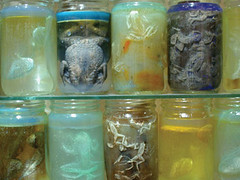Følgende anmeldelse af udstillingen “In the croak room” ved University of Kansas kan — selv om den bruger præparater af frøer og padder — give ideer til hvordan man kan udstille medicinsk-anatomiske præparater på en “æstetisk” måde (fra Nature, 3 nov. 2005):
Nearly one-third of the world’s amphibian species are endangered, and countless have already been lost. Frogs used to be creatures of the wild, but are fast becoming creatures of the lab — pickled, jarred and preserved as a static piece of history. Now some long-dead frogs are taking centre stage as part of an exhibition at the University of Kansas. Creatures from the university’s herpetology collection, along with some from the Field Museum in Chicago, have been cast in urethane in a floor-to-ceiling display of froggy glory.
The show was created by Tracy Hicks, an artist from Texas who has been fascinated by natural-history collections since childhood, when he hatched eggs from turtles, lizards and snakes in his bedroom. The new installation is his tribute to vanishing species and to the science and art of collecting.
Floating in more than 1,300 jars are casts of some 79 species of frogs and tadpoles, many of them extinct, others endangered. They include Atelopus ignescens — once so common in the Andes that they would crunch frequently and unpleasantly under the tyres of passing cars — and the extinct golden toad of Costa Rica’s cloud forests. Other featured species are just bizarre, such as the flying frogs from Asia or the paradox frog, in which a tadpole 25 cm long metamorphoses into an 8-cm frog.

In several cases, Hicks made his casts from the species holotype. He practised for years on less valuable specimens to perfect his technique, and both museums, in Chicago and Kansas, eventually gave him permission to work with their priceless specimens. “This was an opportunity to show that the scientific collection has an aesthetic value to it, a certain beauty,” says John Simmons, manager of the university’s collection and a collaborator on the exhibit.
Most strikingly, Hicks’ translucent casts fluoresce when an ultraviolet light is switched on, transforming the wall of jars into an eerie spectacle, where details such as skin impressions pop out, glowing blue or green. The effect communicates the life of the animals. Audio recordings add to the impression, with a frog chorus of now-vanished species echoing their chants along the walls.
The exhibit, ‘Two Cultures: Collection’, will remain on display until March 2006.
fra: Nature, vol.438, s.27 (3 November 2005)
